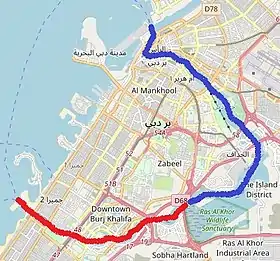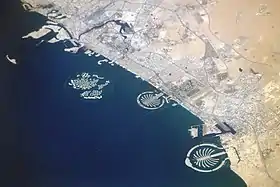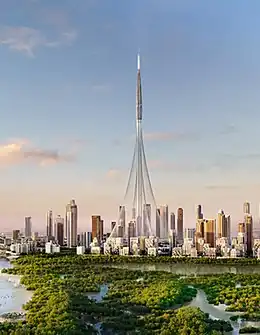Dubai Creek
Dubai Creek (Arabic: خور دبي, romanized: Khūr Dubay) has been described as a natural saltwater creek, tidal inlet, and watercourse or waterway in Dubai, United Arab Emirates (UAE). It extends about 9 miles (14 km) inwards and forms a natural port that has traditionally been used for trade and transport.[1] The creek ranges from 200 to 1,200 metres (660 to 3,940 ft) in width while the average depth is about 6.5 to 7 metres (21 to 23 ft). Previously, it extended to Ras Al Khor Wildlife Sanctuary but as part of the new Business Bay Canal and Dubai Canal, it extends a further 13 km (8.1 mi)[2] to the Persian Gulf.[3] Some sources say that the creek historically extended as far inland as Al Ain, and that the Ancient Greeks called it River Zara.[4]
| Dubai Creek Khūr Dubay | |
|---|---|
 Abras (water taxis) on Dubai Creek | |
| Details | |
| Location | Dubai, United Arab Emirates |
| Length | Total 24 kilometres (15 mi) of which natural length is 14 kilometres (8.7 mi) |
| North end | Al Shindagha area |
| South end | Jumeirah Beach, Jumeirah area |
In the 1950s, extensive development of the creek began, including dredging and construction of breakwaters. A number of bridges allow movement of vehicles across the creek while abras are used as taxis. The banks and route alongside the creek houses notable government, business and residential areas. A number of tourist locations and hotels are situated along the creek.
History

Historically, the creek divided the city into two main sections – Deira and Bur Dubai. It was along the Bur Dubai creek area that members of the Bani Yas tribe first settled in the 19th century, establishing the Al Maktoum dynasty in the city.[5] In the early 20th century, the creek, though incapable then of supporting large scale transportation, served as a minor port for dhows coming from as far away as India or East Africa. Although it impeded the entry of ships due to current flow, the creek remained an important element in establishing the commercial position of Dubai, being the only port or harbour in the city.[6] Dubai's pearling industry, which formed the main sector of the city's economy, was based primarily on expeditions in the creek, prior to the invention of cultured pearls in the 1930s. Fishing, also an important industry at the time, was also based along the creek, whose warm and shallow waters supported a wide variety of marine life. Dhows used for purposes of fishing were also built on the foreshore of the creek.[7]

The importance of the creek as a site of commercial activity was a justification to introduce improvements to allow larger vessels to transit, as well as to facilitate loading and unloading activities. This led, in 1955, to a plan to develop the creek, which involved dredging shallow areas, building of breakwaters, and developing its beach to become a quay suitable for loading and unloading of cargo.[8] The creek was first dredged in 1961 to permit 7-foot (2.1 m) draft vessels to cross through the creek at all times.[9] The creek was dredged again in the 1960s and 1970s so that it could offer anchorage for local and coastal shipping of up to about 500 tons.[10] The dredging opened up the creek to much more continuous traffic of merchandise, including the development of re-export, and gave Dubai an advantage over Sharjah, the other dominant trading centre in the region at the time.[10]
Al Maktoum Bridge, the first bridge connecting Bur Dubai and Deira was constructed in 1963. Although the importance of the creek as a port has diminished with the development of the Jebel Ali Port, smaller facilities, such as Port Saeed, continue to exist along the creek, providing porting to traders from the region and the subcontinent.
2000s

In September 2007, a Dhs. 484 million (US$ 132 million) extension of the creek was finished, which now ends just south of the Metropolitan Hotel and projects on Shaikh Zayed Road. A final 2.2-kilometre extension, called the Dubai Water Canal was inaugurated 9 November 2016, crossing Shaikh Zayed Road in a northerly route, passing through Safa Park and then through Jumeirah 2. The channel is expected to continue through Jumeirah Beach Park where it will reach the shores of the Persian Gulf.[11] The extension is part of the Dubai's Business Bay development. Additionally, a new project consisting of seven islands known as Dubai Creek Harbour was proposed to be built on Dubai Creek. The centerpiece of this project would be the Dubai Creek Tower, which is set to become the tallest building in the world. Three additional bridges are being planned for Dubai Creek, which are the Seventh Crossing, the Al Shindagha Bridge, and the Fifth Bridge.[12][13]
The Dubai Festival City Mall on Dubai Creek opened in 2007. Mohammed Bin Rashid Library is being built in the Al Jaddaf area on the Creek. Dhows are constructed in this area too on the bankside. The Green Line of the Dubai Metro terminates at the Dubai Creek metro station. Close to this metro station is the Al Jaddaf Marine Station, operating ferries on the Creek, including across the Creek to the Dubai Festival City Mall.
Route
Original route
The creek's initial inlet into mainland Dubai is along the Deira Corniche and Al Ras areas of eastern Dubai and along the Al Shindagha area of western Dubai. It then progresses south-eastward through the mainland, passing through Port Saeed and Dubai Creek Park. The creek's natural ending is at the Ras Al Khor Wildlife Sanctuary, 14 kilometres (8.7 mi) from its origin at the Persian Gulf. The traditional form of transport between the eastern and western sections of Dubai via the creek was through abras, which continue to operate in Dubai. In addition, the eastern and western sections are linked via four bridges (Al Maktoum Bridge, Al Garhoud Bridge, Business Bay Crossing, and Floating Bridge) and one tunnel (Al Shindagha Tunnel).
 Original route of Dubai Creek is highlighted in blue. The new extension is highlighted in red.
Original route of Dubai Creek is highlighted in blue. The new extension is highlighted in red. Coast of Dubai from the International Space Station. Dubai Creek is visible.
Coast of Dubai from the International Space Station. Dubai Creek is visible. Dubai International Airport and Dubai Creek figure prominently in this photograph from the International Space Station.
Dubai International Airport and Dubai Creek figure prominently in this photograph from the International Space Station.
Creek extensions
The creek has been extended by 13 km (8.1 mi) through Business Bay, Dubai Canal and through Jumeirah into the Arabian Gulf.

Landmarks
Including the most remarkable buildings alongside the Deira side of the Creek are the Deira Twin Towers, the old Dubai Creek Tower, Sheraton Dubai Creek, National Bank of Dubai, and Chamber of Commerce.[14] On the other side of Al Maktoum Bridge along Dubai Creek is Dubai Creek Park, one of the largest parks in Dubai.[15]
The creek is also home to the Dubai Creek Golf & Yacht Club, comprising an 18-hole tournament golf course, clubhouses, residential development and the Park Hyatt hotel.
Crossings
- Present crossings, in order from northwest to southeast
- Al Shindagha Tunnel
- Al Maktoum Bridge
- Floating Bridge (temporary; to be replaced by the "Dubai Smile" in the future)
- Al Garhoud Bridge
- Business Bay Crossing
- Future/planned crossings
- Dubai Smile (to replace the Floating Bridge)
- Sheikh Rashid bin Saeed Crossing (to link Al Jaddaf and Bur Dubai)
- Al Shindagha Bridge
Ports and marinas
- Port Saeed
- Dubai Creek Harbour
- Al Jaddaf Marine Station
- Business Bay Marina
References

- Gupte 2011, p. 76.
- Hammad 2019, p. 101–102.
- Karanam, Sankarbabu; Juma, Ibrahim Mohammad; AlHarmoudi, Alya Abdulrahim; Yang, Zongyan (30 December 2018). Proceedings of 36th Conference on Coastal Engineering, Baltimore, Maryland, 2018. "Hydrodynamics of Extended Dubai Creek System". Coastal Engineering Proceedings (36): 25. doi:10.9753/icce.v36.currents.25. S2CID 188648755. Retrieved 10 October 2021.
- "Image of Dubai Creek information placard in Dubai Museum". TravelPod.com. Archived from the original on 28 February 2009. Retrieved 19 March 2008.
- Dubai. T. Carter, L Dunston. Lonely Planet. 2006
- Doing Business with the United Arab Emirates. Terterov, Marat. GMB Publishing Ltd. 2006
- "Dubai - Modern History" (PDF). Archived from the original (PDF) on 4 October 2011. (47.0 KB). Department of Tourism and Commerce Marketing. Government of Dubai
- Doing Business with the United Arab Emirates. Terterov, Marat. GMB Publishing Ltd. 2006
- Ruling Shaikhs and Her Majesty's Government, 1960-1969. Joyce, Miriam. Routledge. 2003
- Negotiating Change: The New Politics of the Middle East. Jones, Jeremy. IB Tauris. 2007
- Derek Baldwin (27 September 2007). "Dubai Creek: It Just Got Longer". XPRESS.
- Ahmed, Ashfaq (6 November 2009). "Floating Bridge will stay till 2014". Gulf News.
- "Dubai Traffic, Architecture & Creek Bridges". ciio.unab.edu.co. Archived from the original on 23 February 2014. Retrieved 23 February 2014.
- Dubai Creek Gigapixel Archived 16 April 2009 at the Wayback Machine. Highly detailed view of the Creek on a length of 3 km from Al Sabkha Rd to Chamber of Commerce.
- "Dubai Creek Park" Archived 20 February 2016 at the Wayback Machine, capturedubai.com, 29 March 2015. Retrieved on 30 March 2015.
- Bibliography
- Hammad, Ahmed (June 2019). "Business Bay – Dubai Creek Extension -Construction Management, Challenges and Results. Part II – Project Details" (PDF). Journal of Engineering and Architecture. 7 (1): 100–109. doi:10.15640/jea.v7n1a11. eISSN 2334-2994. ISSN 2334-2986. S2CID 191180349.
- Gupte, Pranay (2011). Dubai: The Making of a Megapolis. Viking. Penguin Books India. ISBN 9780670085170.
Further reading
- Ahmad Makia (April 2015) "Dubai Creek as an Island City-State: Free Zones, Canals, and City Doppelgängers." Avery Review:7

